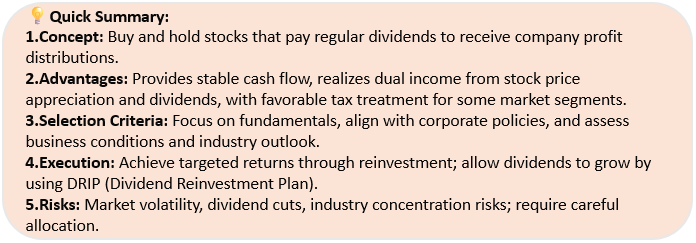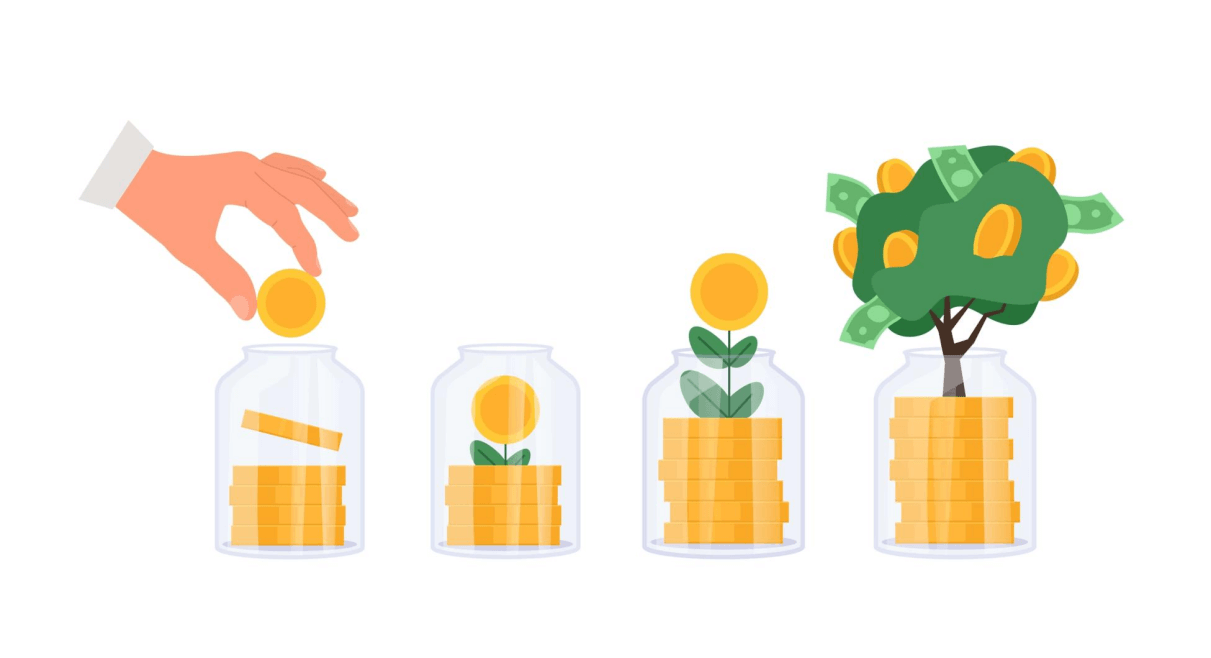TradingKey – Do you want your wealth to grow like a "snowball"? If so, consider exploring dividend investing as a stock investment strategy.
There are many strong dividend stocks in the market. For example, Procter & Gamble (NYSE: PG) has increased its dividends for 69 consecutive years, with a projected dividend yield of 3.3% in 2025 and 65 core brands supporting its business stability.
Some traditional tech companies are transitioning from "growth stocks" to "dividend stocks."For instance, Apple (NASDAQ: AAPL). In Q1 2025, it returned more than $30 billion to shareholders, with the dividend yield rising to 0.6%. Although the dividend yield is not high, its $160 - billion net - cash reserves provide room for future growth.
Similarly, Microsoft (NASDAQ: MSFT) offers a dividend of $3.16 per share with a yield of 0.73%; more than 40% of its revenue comes from cloud services, and stable cash flow underpins long-term dividends.
Now you might be eager to learn what dividend investment strategy entails.
Don't worry; this article will start with the basics of dividend investing and guide you through the concept of this strategy, along with how to select high-dividend stocks to achieve wealth growth.

What is Dividend Investing?
Dividend investing, in simple terms, is an investment approach where investors buy and hold stocks that regularly distribute dividends to receive a share of the company's profits.
Imagine you hold a 1% stake in a company. If the business generates $1 million in annual profits and pays out 10% as dividends, you’d earn $1,000 in dividends each year!
Dividends represent the portion of profit that publicly traded companies return to shareholders based on their ownership stake, typically in the form of cash or additional shares.
How does this differ from stock trading? Instead of fixating on the daily fluctuations in stock prices for quick gains, dividend investing focuses on selecting solid companies that demonstrate consistent profitability and are willing to share their earnings.
Investors profit primarily through stable dividends and gradual appreciation in stock prices.
What are the Advantages of Dividend Investing?
Stable Cash Flow: No Worries During Market Crashes!
Even if stock prices experience dramatic declines—like during the pandemic when U.S. markets faced halts—dividends continue to be paid as long as the company's performance remains solid.
Dual Benefits: Increasing Stock Prices + Higher Dividends
As quality companies continue to grow, their stock prices typically rise (capital gains), and dividends tend to increase as well. This means investors can enjoy double the returns.
Tax Benefits: A Bonus for Investors!
In many markets (such as the U.S.), qualified dividends are taxed at significantly lower rates than ordinary income, with rates ranging from 0% to a maximum of 20%.
For instance, if you're subject to a 30% tax rate on your salary, your tax liability on dividends may drop to about 15%.
Over time, this can lead to substantial savings—essentially acting like a subsidy from the government!

(Source: Shutterstock)
How to Choose High-Dividend Stocks? What Are the Selection Criteria?
Selecting high-dividend stocks is a critical aspect of the dividend investing strategy, requiring a comprehensive consideration of multiple factors and the establishment of sound selection criteria.
Stable Profitability
Dividends are fundamentally rooted in a company’s consistent ability to generate profits.
Companies that experience "roller coaster" earnings——Companies whose earnings rollercoaster from $100 million in profits one year to $50 million in losses the next — the classic "earnings rollercoasters" — can’t sustain reliable dividends!
When reviewing financial statements, focus on these two figures:
✅ Revenue and Net Profit: Look for continuous growth over 5 years or more (e.g., an annual increase of 5%-10%), indicating a solid and resilient business.
❌ Beware of "Fake Gains": Companies that rely on selling assets or government subsidies (non-recurring income) have poor earnings quality, making dividend sustainability uncertain.
Reasonable Dividend Policy
Dividend Payout Ratio = Dividend Amount ÷ Net Profit
While high dividend yields can be enticing, investors need to approach them with caution.
Typically, a payout ratio between 30% and 70% is considered healthy.
If the payout ratio is too high, it may indicate "stretching the budget," as it implies that all future development funds are being paid out in dividends, which can hinder expansion and result in unsustainable dividends.
Conversely, a very low payout ratio may suggest that the company is reluctant to share profits with shareholders despite generating substantial earnings.
Financial Health
If a company is burdened with excessive debt, how can it pay dividends? Focus on these two metrics:
Debt-to-Asset Ratio < 60%: High debt levels (e.g., over 70%) mean that most profits are used for interest payments, leaving little for shareholders. Opt for companies with lower debt ratios (for example, many companies in consumer goods and pharmaceuticals have debt ratios around 30%).
Operating cash flow must be substantial—because paper profits don’t equal cash in hand!
Consider a company reporting $100 million in annual profits but only collecting $50 million due to customers’ unpaid invoices.
In such cases, their dividends could practically be IOUs.Always check if the net operating cash flow remains positive over time and can cover dividend payments.
Follow Major Trends, Avoid Sunset Industries
The macroeconomic environment and industry outlook determine whether a company can survive long-term.
During economic downturns, opt for "defensive essentials" such as utilities, food & beverages, and healthcare; no matter how well or poorly the economy performs, people will still need these services—leading to more stable dividends.
Avoid “declining sectors”: For instance, traditional fuel vehicles are being overshadowed by electric vehicles; even if such industries have high current dividends, they might face cuts in the future.
Look for Undervalued Potential Stocks
Some industries may experience short-term setbacks (e.g., airlines post-pandemic), but leading companies often possess strong competitive advantages; once conditions improve, their dividends may see substantial increases!
How to Achieve Compound Growth Through Dividend Reinvestment?
Compound growth involves reinvesting the dividends you receive back into the stock market to purchase additional shares.
This process generates even more dividends in subsequent periods, leading to exponential asset growth.
What is Dividend Reinvestment? The Core Secret of Compounding!
Suppose you own 100 shares of Company A, with an annual dividend of $10 per share—year one yields $1,000 in dividends.
The spend-and-hold approach: Take the $1,000 as cash. Next year, you’ll still have 100 shares, earning the same $1,000 dividend.
The compounding approach: Reinvest the $1,000 to buy 10 additional shares (at $100/share). By year two, your 110 shares generate $1,100 in dividends. Reinvesting that $1,100 buys 11 more shares (assuming a stable price), growing your position to 121 shares by year three—now yielding $1,210.
Each reinvested dividend adds to your share count, making future dividends bigger—the classic "snowball effect" of compounding.
This illustrates the power of compounding: every time you receive dividends and convert them into more shares, future dividends begin to snowball over time. The longer this process continues, the more impressive the results become!
DRIP Plans—Making Compound Growth Effortless!
If you're concerned about manual management, many brokers and companies offer Dividend Reinvestment Plans (DRIPs) that automate this process for you.
Once your dividends are credited to your account, they are automatically used to purchase additional shares—often with waived trading fees—allowing you to truly "earn while you sleep."
Additionally, these plans allow for flexible strategy adjustments:
When market valuations are low, consider increasing your dividend reinvestment efforts to acquire more shares at a lower cost.
Conversely, during periods of high valuations, it may make sense to reduce your reinvestment rate slightly and allocate some of your expected dividends toward other investments.
Over time, this disciplined approach can lead to substantial wealth growth because compounding amplifies every dollar that gets reinvested.

(Source: Freepik)
What Risks Exist?
While dividend investing can offer benefits like reduced volatility and stable income, it comes with several risks that investors should be aware of.
Beware of Market Fluctuations
Investing in dividend stocks does not protect against market volatility.
Stock values can fluctuate significantly due to events impacting specific companies or the broader market.
Economic crises, policy changes, and unexpected events (like wars or pandemics) can cause sharp price declines.
Even reliable dividend stocks may drop in value, potentially eroding your overall portfolio—even if dividends continue to be paid.
Tip: Don’t focus solely on dividends; maintain a portion of your funds to manage price fluctuations or consider hedging with low-volatility assets like bonds.
Dividend Cuts or Suspensions—Don’t Treat Dividends as Guaranteed Income
Dividends are not guaranteed! A decline in company performance, cash flow constraints, or the need for significant investment can lead to dividend reductions.
During economic downturns, many companies prioritize survival over paying dividends. If you depend on these dividends for your income, you might encounter significant difficulties.
Concentration Risk—Issues in One Sector Can Affect Your Entire Portfolio
Dividend stocks are often concentrated in sectors like utilities and consumer goods.
While these may seem stable, they carry significant risks. Problems within an industry—such as renewable energy disrupting traditional energy sources or e-commerce affecting brick-and-mortar retail—can lead to major declines in sector-related dividend stocks. If your investments are too concentrated, you risk substantial losses across your entire portfolio.


